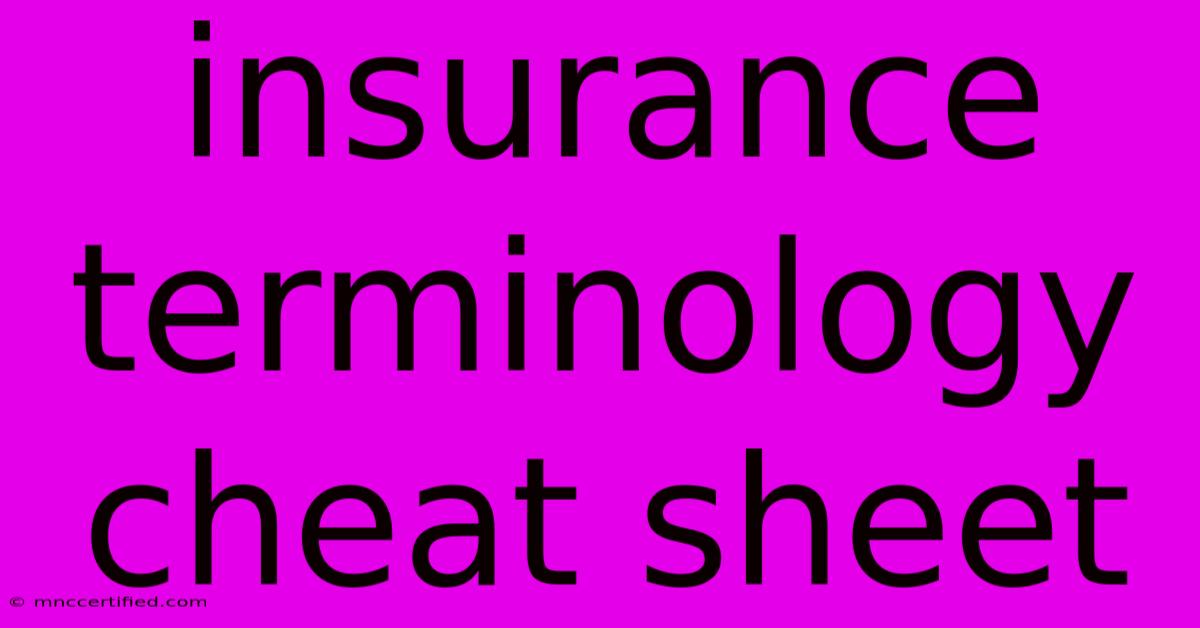Insurance Terminology Cheat Sheet

Table of Contents
Insurance Terminology Cheat Sheet: Demystifying the Jargon
Navigating the world of insurance can feel like learning a new language. This cheat sheet breaks down common insurance terminology, helping you understand policies, claims, and everything in between. Whether you're a seasoned policyholder or just starting out, this guide will empower you to make informed decisions.
Key Insurance Terms Explained
This section defines essential terms, categorized for easy understanding.
Policy Basics:
- Policy: A legally binding contract between an insurer (the company providing insurance) and an insured (the person or entity receiving insurance). This document outlines the terms, conditions, coverage, and exclusions.
- Insurer/Underwriter: The insurance company that assesses risk and issues policies. Underwriters specifically evaluate applications to determine eligibility and premiums.
- Insured: The individual, business, or entity protected under the insurance policy.
- Premium: The regular payment made to maintain an insurance policy.
- Deductible: The amount you pay out-of-pocket before your insurance coverage kicks in. For example, a $500 deductible means you pay the first $500 of a claim.
- Copay: A fixed amount you pay for a covered healthcare service, like a doctor's visit.
- Coinsurance: Your share of the costs of a covered healthcare service, calculated as a percentage (e.g., 20%).
- Out-of-Pocket Maximum: The most you'll pay out-of-pocket during a policy period (usually a year). Once you reach this limit, your insurance covers 100% of covered services.
- Claims: A formal request for payment from an insurance company after an insured event (accident, illness, etc.).
- Beneficiary: The person or entity designated to receive the benefits of a life insurance policy or other insurance products upon the death of the insured.
Types of Coverage:
- Liability Insurance: Protects you against financial losses from claims of bodily injury or property damage caused by you or your actions. Common examples include auto liability and general liability insurance.
- Property Insurance: Covers damage or loss to your property due to events like fire, theft, or natural disasters (e.g., homeowners, renters, business property insurance).
- Health Insurance: Provides coverage for medical expenses, including doctor visits, hospital stays, and prescription drugs.
- Life Insurance: Pays a death benefit to your beneficiaries upon your death. This provides financial security for your loved ones.
- Disability Insurance: Replaces a portion of your income if you become unable to work due to illness or injury.
- Auto Insurance: Covers damage to your vehicle and liability for accidents. Common types include collision, comprehensive, and uninsured/underinsured motorist coverage.
Understanding Exclusions:
- Exclusions: Specific events or circumstances that are not covered under your insurance policy. Carefully reviewing exclusions is crucial to avoid unexpected costs. For example, flood damage might be excluded from a standard homeowners policy.
Tips for Navigating Insurance Jargon
- Read your policy carefully: Don't hesitate to ask for clarification from your insurer if anything is unclear.
- Compare policies: Don't settle for the first policy you find. Shop around and compare coverage, premiums, and deductibles.
- Use online resources: Many websites offer explanations of insurance terms and concepts.
- Consult an insurance professional: An independent insurance agent can help you find the right coverage for your needs.
SEO Optimization Strategies
This article incorporates several SEO strategies:
- Keyword Targeting: The article uses relevant keywords like "insurance terminology," "insurance cheat sheet," "policy," "premium," "deductible," "liability insurance," "health insurance," and various other related terms.
- Header Structure (H2, H3): Clear headings and subheadings improve readability and help search engines understand the content structure.
- Bold Text: Emphasizes key terms for both readers and search engine crawlers.
- Internal Linking (Not implemented here, but recommended for a real website): Linking to other relevant articles on your website improves user experience and SEO.
- External Linking (Not implemented here, but recommended for a real website, particularly to reputable insurance information sites): Adding links to authoritative sources enhances credibility.
- Long-form Content: Providing comprehensive information increases the chances of ranking higher in search results.
By understanding these insurance terms and implementing effective SEO techniques, you'll be well-equipped to navigate the world of insurance with confidence. Remember to always thoroughly review your policy documents and seek professional advice when needed.

Thank you for visiting our website wich cover about Insurance Terminology Cheat Sheet. We hope the information provided has been useful to you. Feel free to contact us if you have any questions or need further assistance. See you next time and dont miss to bookmark.
Featured Posts
-
Sinus Surgery Cost With Insurance
Nov 19, 2024
-
Pregnant Jennifer Lawrences Chocolate Dress
Nov 19, 2024
-
Parks Thanksgiving Weekend Announcement
Nov 19, 2024
-
Gaudette Insurance Northbridge Ma
Nov 19, 2024
-
New Mom Jennifer Lawrences Dress
Nov 19, 2024